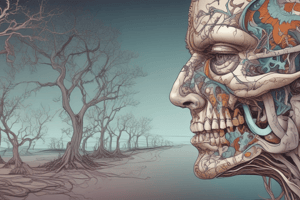Podcast
Questions and Answers
What is the main cause of neurogenic bladder?
What is the main cause of neurogenic bladder?
- Neurologic damage (correct)
- Urinary tract infection
- Kidney stones
- Bladder inflammation
What are the two types of neurogenic bladder?
What are the two types of neurogenic bladder?
- Flaccid and spastic (correct)
- Flaccid and rigid
- None of the above
- Rigid and spastic
What type of incontinence results from both types of neurogenic bladder?
What type of incontinence results from both types of neurogenic bladder?
- Urge incontinence
- Overflow incontinence (correct)
- Stress incontinence
- Mixed incontinence
What are some signs and symptoms of neurogenic bladder?
What are some signs and symptoms of neurogenic bladder?
What diagnostic tests are used to diagnose neurogenic bladder?
What diagnostic tests are used to diagnose neurogenic bladder?
What is the outcome of neurogenic bladder if the underlying cause is diagnosed and treated early?
What is the outcome of neurogenic bladder if the underlying cause is diagnosed and treated early?
What medical treatments are used for neurogenic bladder?
What medical treatments are used for neurogenic bladder?
What does bladder training for neurogenic bladder involve?
What does bladder training for neurogenic bladder involve?
What are some prevention measures for neurogenic bladder?
What are some prevention measures for neurogenic bladder?
What is the difference between flaccid and spastic neurogenic bladder?
What is the difference between flaccid and spastic neurogenic bladder?
What is the main symptom of overflow incontinence?
What is the main symptom of overflow incontinence?
What is the main cause of recurrent UTIs in neurogenic bladder?
What is the main cause of recurrent UTIs in neurogenic bladder?
Flashcards are hidden until you start studying
Study Notes
- Neurogenic bladder is caused by neurologic damage
- It can be caused by various conditions
- It can be flaccid or spastic
- Both types result in overflow incontinence
- Recurrent UTIs and urinary calculi are signs and symptoms
- Diagnosis includes X-ray, post-void residual volume measurement, and renal ultrasound
- Good outcome if underlying cause is diagnosed and treated early
- Medical treatments include catheterization, bladder training, and surgery
- Bladder training includes voiding diary and Kegel exercises
- Prevention measures include renal function monitoring and control of UTIs and urinary calculi.
Studying That Suits You
Use AI to generate personalized quizzes and flashcards to suit your learning preferences.




